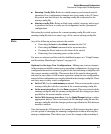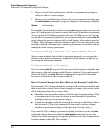
6-4
Switch Memory and Configuration
Overview of Configuration File Management
“permanent”. When you are satisfied that the change is satisfactory, you can
make it permanent by executing the write memory command. For example,
suppose you use the following command to disable port 5:
ProCurve(config)# interface ethernet 5 disable
The above command disables port 5 in the running-config file, but not in the
startup-config file. Port 5 remains disabled only until the switch reboots. If
you want port 5 to remain disabled through the next reboot, use write memory
to save the current running-config file to the startup-config file in flash
memory.
ProCurve(config)# write memory
If you use the CLI to make a configuration change and then change from the
CLI to the Menu interface without first using write memory to save the change
to the startup-config file, then the switch prompts you to save the change. For
example, if you use the CLI to create VLAN 20, and then select the menu
interface, VLAN 20 is configured in the running-config file, but not in the
startup-config file. In this case you will see:
ProCurve(config)# vlan 20
ProCurve(config)# menu
Do you want to save current configuration [y/n]?
If you type
[Y], the switch overwrites the startup-config file with the running-
config file, and your configuration change(s) will be preserved across reboots.
If you type
[N], your configuration change(s) will remain only in the running-
config file. In this case, if you do not subsequently save the running-config file,
your unsaved configuration changes will be lost if the switch reboots for any
reason.
Storing and Retrieving Configuration Files. You can store or retrieve a
backup copy of the startup-config file on another device. For more informa-
tion, see appendix A, “File Transfers” .


















